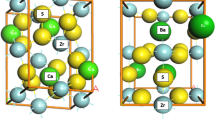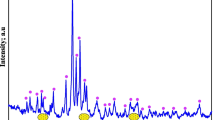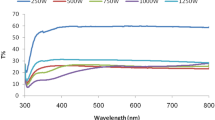Abstract
The MIR reflectivity spectra ranging from 4000 to 900 cm−1 of the polarons in zinc oxide films doped with 0.24 at.% silver (AgZnO) as a function of temperature (190–360 K) in weakly concentrated gaseous methane environment were obtained. The decay rate, energy and intensity of polaron states at 1248 and 1484 cm–1 are analyzed using the Lorentzian line-shape function. The lines show the redshift (~ 3%) with an increase in temperature. The width and intensity of the line at 1248 cm–1 decrease by 23% and 38%, respectively, with an increase in temperature to 360 K. The one-phonon line at 1484 cm–1 broadens by ~ 50%, and the intensity decreases by 54% upon reaching a temperature of 330 K, and at T ≥ 350 K, the line 1484 cm–1 decays into many ultrafine weakly localized states due to the formation of a hydrocarbon adsorbate, which acts as a charge trapping center on the AgZnO surface. The calculated polaron scattering time τ = 2.2 fs decreases to 1.8 fs as the temperature rises from 250 to 360 K. The frequency dependences of the optical conductivity determined by Kramers–Kronig relations show a localization-delocalization crossover near 1900 cm–1. At frequencies below 1900 cm–1, the carriers are localized, and dc-conductivity satisfies the criterion of the Mott-VRH model with the hopping energy of 0.43 T3/4 meV.









Similar content being viewed by others
Data availability
Data openly available in a public repository that issues datasets with DOIs The data that support the findings of this study are openly available in [repository name e.g “figshare”] at https://doi.org/10.1007/s00339-024-07324-x, reference number [00339_APYA-D-23-02487].
References
A.B. Djurišić, A.M.C. Ng, X.Y. Chen, ZnO nanostructures for optoelectronics: material properties and device applications. Prog. Quantum Electron. 34, 191–259 (2010)
E. Fortunato, P. Barquinha, R. Martins, Oxide semiconductor thin-film transistors: a review of recent advances. Adv. Mater. 24, 2945–2986 (2012)
T. Pauporté, O. Lupan, J. Zhang, T. Tugsuz, I. Ciofini, F. Labat, B. Viana, Low-temperature preparation of Ag-doped ZnO nanowire arrays, DFT study, and application to light-emitting diode. ACS Appl. Mater. Interfaces 7, 11871–11880 (2015)
Yanfa Yan, M.M. Al-Jassim, S.-H. Wei, Doping of ZnO by group-IB elements. Appl. Phys. Lett. 89, 181912–181913 (2006)
M. Thomas, W. Sun, J. Cui, Mechanism of Ag doping in ZnO nanowires by electrodeposition: experimental and theoretical insights. J. Phys. Chem. 116, 6383–6391 (2012)
W.J. Li, C.Y. Kong, H.B. Ruan, G.P. Qin, G.J. Huang, T.Y. Yang, W.W. Liang, Y.H. Zhao, X.D. Meng, P. Yu, Y.T. Cui, L. Fang, Electrical properties and Raman scattering investigation of Ag doped ZnO thin films. Solid State Commun.Commun. 152, 147–150 (2012)
Y. Kanai, Admittance spectroscopy of ZnO crystals containing Ag. Jpn. J. Appl. Phys.. J. Appl. Phys. 30, 2021–2022 (1991)
A. Wibowo, M. Agung Marsudi, M. Ikhlasul Amal, M. Bagas Ananda, R. Stephanie, H. Ardy, L. Jaya Diguna, ZnO nanostructured materials for emerging solar cell applications. RSC Adv. 10, 42838–42859 (2020)
S. Mangala-Nagasundari, K. Muthu, K. Kaviyarasu, D.A. Al Farraj, R.M. Alkufeidy, Current trends of silver doped zinc oxide nanowires photocatalytic degradation for energy and environmental application. Surf. Interfaces 23, 100931–100943 (2021)
C. Cao, B. Zhang, S. Lin, p-type ZnO for photocatalytic water splitting. APL Mater. 10, 030901–030913 (2022)
L. Zhang, H.H. Mohamed, R. Dillert, Kinetics and mechanisms of charge transfer processes in photocatalytic systems: a review. J. Photochem. Photobiol. C: Photochem. Rev. 13, 263–276 (2012)
A. Solbrand, K. Keis, S.A. Södergren, H. Lindstrom, Charge transport properties in the nanostructured ZnO thin film electrode—electrolyte system studied with time resolved photocurrents. Sol. Energy Mater. Sol. Cells 60, 181–193 (2000)
C. Franchini, M. Reticcioli, M. Setvin, Ulrike Diebold, Polarons in materials. Nat. Rev. Mater. 6, 560–586 (2021)
Jarvist Moore Frost, Polaron mobility.jl: Implementation of the Feynman variational polaron model. JOSS 3, 566 (2018)
T. Feng, L. Li, Q. Shi, S. Dong, B. Li, K. Lia, G. Li, Evidence for the influence of polaron delocalization on the electrical transport in LiNi0.4+xMn0.4−xCo0.2O2. Phys. Chem. Chem. Phys. 22, 2054–2060 (2020)
A.S. Mishchenko, N. Nagaosa, A. Alvermann, H. Fehske, G. De Filippis, V. Cataudella, O.P. Sushkov, Localization-delocalization transition of a polaron near an impurity. Phys. Rev. B 79, 180301–180305 (2009)
M. Moser, A. Savva, K. Thorley, B.D. Paulsen, T. Cecilia Hidalgo, D. Ohayon, Hu Chen, A. Giovannitti, A. Marks, N. Gasparini, A. Wadsworth, J. Rivnay, S. Inal, I. McCulloch, Polaron delocalization in donor-acceptor polymers and its impact on organic electrochemical transistor performance. J. German Chem. Cociety 60, 7777–7785 (2021)
A.E. Myasnikova, Temperature dependence of electrical conductivity in systems with large polarons and bipolarons. Phys. Lett. A 291, 439–446 (2001)
O. Verzelen, R. Ferreira, G. Bastard, Polaron lifetime and energy relaxation in semiconductor quantum dots. Phys. Rev. B 62, R4809–R4812 (2000)
P. Calvani, Optical properties of polarons. La Rivista del Nuovo Cimento 24, 1–71 (2001)
D. Emin, Optical properties of large and small polarons and bipolarons. Phys. Rev. B 48, 13691–13703 (1993)
H. Sezen, H. Shang, F. Bebensee, C. Yang, M. Buchholz, A. Nefedov, S. Heissler, C. Carbogno, M. Scheffler, P. Rinke, C. Woll, Evidence for photogenerated intermediate hole polarons in ZnO. Nat. Commun.Commun. 6, 7694–7698 (2015)
Q. Liu, H. Chen, Z. Wang, Y. Weng, Observation of the polaron excited state in a single-crystal ZnO. J. Phys. Chem. C 125, 10274–10283 (2021)
D.A. Panayotov, J.T. Yates, n-Type doping of TiO2 with atomic hydrogen-observation of the production of conduction band electrons by infrared spectroscopy. Chem. Phys. Lett. 436, 204–208 (2007)
K. Shportko, P. Zalden, A. Lindenberg, R. Rückamp, Anharmonicity of the vibrational modes of phase-change materials: a far-infrared, terahertz, and Raman study. Vib. Spectrosc.. Spectrosc. 95, 51–56 (2018)
A.V. Vasin, A.V. Rusavsky, S.V. Mamykin, A.S. Nikolenko, V.V. Strelchuk, R. Yatskiv, J. Grym, A.I. Gudimenko, V.P. Kladko, I.P. Tyagulskyy, J. Lorinčik, I. Elantyev, A.N. Nazarov, On the nature of doping effect of methane in ZnO thin films deposited by RF-magnetron sputtering. J. Mater. Sci. Mater. Electron. 33, 6421–6431 (2022). https://doi.org/10.1007/s10854-022-07814-
O. Lupan, T. Pauporté, L.C. How, B. Viana, F. Pellé, L.K. Ono, B. Roldan Cuenya, H. Heinrich, Effects of annealing on properties of ZnO thin films prepared by electrochemical deposition in chloride medium. Appl. Surf. Sci. 256, 1895–1907 (2010). https://doi.org/10.1016/j.apsusc.2009.10.032
Acknowledgements
This work was partly supported by Science Committee of Armenia (Grants No. 21T-2F024 and 21T-1C150).
Author information
Authors and Affiliations
Contributions
All authors were involved in experiment and interpretation of results. All authors has approved submission of this manuscript.
Corresponding author
Ethics declarations
Conflict of interest
The authors declare that they have no known competing financial interests or personal relationships that could have appeared to influence the work reported in this paper.
Additional information
Publisher's Note
Springer Nature remains neutral with regard to jurisdictional claims in published maps and institutional affiliations.
Rights and permissions
Springer Nature or its licensor (e.g. a society or other partner) holds exclusive rights to this article under a publishing agreement with the author(s) or other rightsholder(s); author self-archiving of the accepted manuscript version of this article is solely governed by the terms of such publishing agreement and applicable law.
About this article
Cite this article
Sarkisian, A.R., Aghamalyan, N.R., Nersisyan, M.N. et al. On polaron stability in Ag-doped ZnO films. Appl. Phys. A 130, 207 (2024). https://doi.org/10.1007/s00339-024-07324-x
Received:
Accepted:
Published:
DOI: https://doi.org/10.1007/s00339-024-07324-x




